by Angell Delaney
Playing like a girl is no longer an insult. It’s a HOOP DREAM millions aspire to.
Thousands of females, from skinned-kneed kindergartners to the silver-haired and stiff-of-joint, pour through the gates of New York City’s Madison Square Garden. Their T-shirts and jerseys, emblazoned with large 50s and 11s, conform to an unwritten dress code. The decibels reach a painful level as fans stomp, roar, and clap when favorite players drive to the basket, stop short for a jump shot or dive off the court for a loose ball. Banners billow, proclaiming “Give me Liberty, Give me Lobo,” or “Lesbians for Liberty,” as the audience bellows. Post-game, hordes roam the hallways in search of autographs or glimpses of their heroes: Rebecca Lobo (number 50), Teresa Weatherspoon (number 11), Kym Hampton (number 34). “There’s Sue Wicks!” screams an enthusiastic 12-year-old as she takes off running, with a growing crowd behind her.
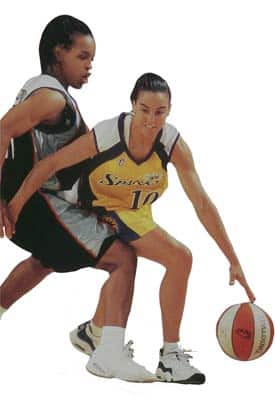
Where did this new sporting phenomenon, known as the WNBA (Women’s National Basketball Association), come from? Why are there suddenly McDonald’s commercials that combine kids, Chicken McNuggets and the WNBA Defensive Player of the Year, Teresa Weatherspoon? Women’s pro basketball is not, after all, a novel concept in the U.S. The Women’s Professional Basketball League lasted three seasons (1978-81), as did the Women’s World Basketball Association (199295). These were leagues before their time. The media coverage was missing, and – in the absence of the years of high-tech training that has transformed male basketball – so was a professional level of play. Then there was the liberty Basketball Association, which sank, blessedly, into retirement after a single exhibition game in 1991. In nipple-revealing unitards so tight the women looked shrink wrapped, they played on shortened courts, with lowered baskets. At this game, which confused players with playgirl cheerleaders, it wasn’t just the baskets that were lowered. Whatever this was, it wasn’t pro basketball.
Since Nixon signed of Title IX of the Civil Rights Act in 1972, which required schools and colleges receiving federal funding to offer equal opportunities to female athletes, the number of girls and women participating in sports in this country has increased more than eightfold. Today, there are an estimated 2.5 million girls in high school sports, compared to 294,000 twenty-five years ago, according to the National Federation of High School Associations. As a result there are more women prepared for the rigors of professional sports, and an ever-growing number of fans anxious to see women competing in their favorite sports – both of which translate into increased respect for female athletes and athletic events. Nowhere has this been so clearly demonstrated as in women’s basketball. In 1996, the USA women’s Olympic team drew over 30,000 spectators to each of its six consecutive games on their way to capturing the gold medal. That same year, A record 2.85 million households watched the NCAA women’s championship on ESPN.
These numbers, and the fact that last year some 41 million American females regularly participated in sports and outdoor activities, gave savvy NBA executives a green light to launch the WNBA. The first game of the eight-team league was in June, 1997. And by season’s end, in August, auditoriums nationwide were packed to capacity, double the attendance projections. National TV coverage didn’t hurt. At their 28 games this summer, over one million fans attended in person, and an additional 50 million tuned in to NBC (which captured mainstream viewers), ESPN (for hardcore sports aficionados), or Lifetime (which attracts a mainly female audience). It was a stunning beginning. The WNBA’s inaugural season, say sports analysts, received the most thorough coverage of any startup league in the history of any sport. Unlike the NBA crowd, which is mostly male, white, and white-collar corporate (who else can afford tickets that begin at $20, and range upward of $1,500 for courtside seats?), the WNBA audience is unprecedentedly diverse in race, age and socio-economic background. And while they are predominantly female, there are also significant numbers of men: kids, boyfriends and fathers with their daughters, as weD as those who attend the game out of curiosity or simple addiction to the sport. With ticket prices between $8 and $45 (and courtside seats at $150), the WNBA is one of the most affordable and accessible professional sports around.
Revolutionary numbers of women are securing their places and season tickets in arenas that have traditionally been bastions of masculinity. Sociologists please note: contrary to studies that find young girls in mixed-gender groups tend toward timidity and shyness, these youthful female fans are yelling the loudest, and strong-arming their way ahead of boys and men for souvenirs, handshakes, and hugs from players. They are dedicated (and determined) in their devotion. One third grade New York Liberty fan was observed battling through the crowd like a small tank. Arriving triumphantly at the front of the souvenir stand, she proudly proclaimed (and probably started a trend) that she’d named her pet hamster after the Liberty’s starting center, Rebecca Lobo.
Role model responsibility
Unlike many professional sports where the male stars and supposed role models are at best often immature and avaricious, and at worst, spouse and substance abusers, the women of the WNBA represent a new kind of hero. Gracious and generous to their fans, they warm to crowds in ways most male players, as spoiled as rock stars or foreign potentates, wouldn’t deign to do. Michele Timms, the Phoenix Mercury’s point guard, spent two hours in the scorching sun signing autographs after a grueling game. Forced to leave for another appointment while fans were still on line, she penned an apologetic letter to them, published in the Arizona Republic newspaper, for not getting to all of them that day.
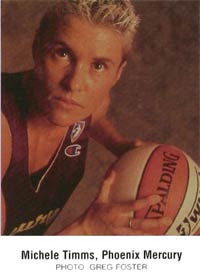
“Being a role model is my most important contribution to women’s basketball,” says the 32-year-old Timms, and you believe her. Other WNBA players feel the same way. Perhaps these women take the responsibility seriously because they grew up in a world with few women sports heroes. “It wasn’t until high school that I had a chance to see women play, it’s a lot different now,” says Los Angeles Sparks point guard Jamila Wideman. “I hope to be a role model both on and off the floor. I’d like girls to see that it’s okay to be competitive and aggressive. They aren’t always encouraged in that. But while I give everything I’ve got to the game, I also think there’s a place for unselfishness on the floor. On or off the floor, the way I present myself should be why someone does or does not respect me. Not because I dribble well.”
And dribble well they do. But the action on the women’s basketball court differs from men’s. “It’s a totally different game,” says Sue Wicks, the Liberty’s 6’3″ center. “If you go to women’s pro basketball looking for men’s playing style, you won’t find it.” A number of the women’s basketball regulations are based on gender-indifferent collegiate play, such as the distance of the three point line, the size of the ball, and the free throw lane, in an effort to keep the game fast and furious. But many of the rules for women’s pro basketball were adopted from the NBA. The court is the same size, and the baskets are the same height – 10 feet. The women, however, are a lot shorter. Male basketball players often reach seven feet or more, women usually top out at 6’4″, but can be considerably shorter – the Sparks’ Wideman is only 5’6″.
One of the most noticeable differences between the two games is that men spend a lot of time dunking – -it’s easier to jam the ball into the hoop when you need to do little more than fully extend your arm. Most women players, who by comparison are height-challenged, have to find more creative ways to get the ball to the basket. Even the few who can dunk often don’t because of the threat of injury posed by the congestion under the basket in women’s games. Women’s basketball may be a tad slower than men’s, but it’s a more strategic and team-oriented form of the game. And what fans seem to enjoy most about the new women’s game is that it matches the intensity of men’s pro basketball. These women may not be making all the same moves as Michael Jordan, but they are as skilled in what they do, as aggressive, as willing to work up as much of a sweat and to dive for the ball as often. Both games are physically and emotionally demanding. They can also be bruising, as 6’1″ Houston Comets forward Wanda Guyton knows. During the playoffs this summer, Comets forward Tina Thompson went up for a rebound and smashed into Guyton on the way down, knocking her out cold. Fans watched anxiously as she was carried off on a stretcher, wearing a neck immobilizer.
But the most striking difference between the men’s and women’s leagues is not in the number of points or rebounds per game, or the number of injuries, but in salary. In sports, as in the ordinary workplace, women still have a long way to go to achieve parity in income. The average male player makes $28,000 a game, for a season’s total of some $2.3 million. The average WBNA player makes only slightly more than that, $30,000 – for an entire season. Even the highest paid WNBA stars Lisa Leslie, Rebecca Lobo, and Sheryl Swoopes – receive an estimated $250,000 annually, while NBA players like Patrick Ewing rake in upwards of $17 million Endorsements are much less of a bonus for women. Lobo has a sizeable Reebok contract, and Swoopes a Nike shoe named after her (both women endorse a variety of other products), but women’s deals pale in comparison to men’s endorsement portfolios. Men’s endorsements still dwarf women’s by about 10 to one. Absent from WNBA games, happily, are the troupes of scantily-clad women who dance for a mostly male audience. Absent too are the stars on occasion, for a reason never seen in male basketball – maternity leave. Comets guard Sheryl Swoopes, one of the league’s most celebrated players, missed two-thirds of this summer’s games because she went into labor shortly after the season opened. She returned to play five weeks after the birth of her first child. While Sheryl ran the Comets offense, child care for her infant son Jordan was supplied by his stay-at-home father, Eric Jackson.
Balanced Lives
Women players, long denied the opportunity to play professional sports in this country, frequently had careers in other professions before basketball. Cleveland Rockers’ guard Lynette Woodard, who was the first female Harlem Globetrotter, is a stockbroker, who uses a laptop and cell phone to stay in touch with her clients from the road. Both “games” are similar, she says, describing how brokers and basketball players have to “hustle, play good defense, and rebound when things go wrong.” Jamila Wideman is a Stanford University graduate, law school bound in 1998 (incidentally, she is also the daughter of Pulitzer Prize-winning author John Edgar Wideman). Rhonda Blades, the Liberty’s three-point specialist, is a nurse practitioner.
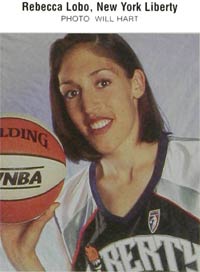
Aside from a more rounded life than many male players, the WNBA’s women display a gratitude for the league that is usually lacking in professional sports. “I feel fortunate and blessed by God to have this chance,” says basketball mega-star Rebecca Lobo. “When I look back fifty years from now, I know 111 feel proud to be one of the first people to get this thing off the ground.” It’s a refreshingly humble response for an athlete of her stature – 24-year-old Lobo is an Olympic gold medallist, NCAA champion, and WNBA superstar.
The women are also giving back to the communities that support them. Breast cancer is a concern for female players, as it is for all women, and during time outs and half time, as part of the league’s “Shoot for the Cure” campaign, female fans shoot jump shots to raise money for breast cancer research. Cynthia Cooper, a guard for the league champion Comets and the WNBA’s Most Valuable Player this year, appears in public service ads for breast cancer awareness and education, and openly discusses her mother’s battle with the disease. Off the court, players donate their time to sports clinics for underprivileged girls.
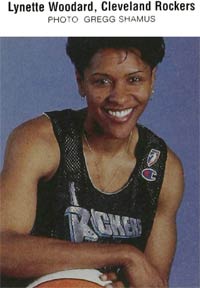
Forced abroad for recognition (and dollars) Surprisingly, since American women started playing basketball in 1892 (wearing floor- length frocks at Smith College), we lag behind most of the rest of the world in appreciating women’s basketball. For decades, there have been professional women’s leagues in Brazil, China, Hungary, Italy, Japan, Russia, and Turkey, to name just a few, and the best American players have traveled thousands of miles to compete at a level that was unavailable to them in the U.S.. Equally surprising is the fact that the foreign teams often pay their players substantially more. Hungary offered ABL player, Katrina McClain $300,000 to woo her to Europe. The American forward turned it down for one-sixth of that sum to play on the U.S. Olympic team. “I was earning $20,000 a month in Japan,” Kym Hampton, the 6’2″ Liberty center told On The Issues, an income she has yet to match in the US.
Player traffic is now beginning to go the other way, in our direction, despite the lower American pay scales. Major contributing factors are the higher level of play and larger concentration of star players currently in the States. A number of the world’s top players – Australia’s Michele Timms (Phoenix Mercury), Russia’s Elena Baranova (Utah Starzz) and China’s Zheng Haixia (Los Angeles Sparks) among them – left home to join American teams.
Room for Two Leagues?
The NBA is also not the only league that the WNBA is compared to, on or off the I court. Women of the I American Basketball League (ABL) are also vying for the attention of the American public. Both women’s leagues have similarly high version of Helen Ready’s “I Am Woman.” Young girls can now see their futures in tenacious point guards like Teresa Weatherspoon, or in sports league presidents like I the WNBA’s Val Ackerman.
The hype around levels of competitive play, and both feature star players from the NCAA championship team and the 1996 Olympic team. The major difference between the two leagues, however, is medial magic and marketing. While the ABL spent $1.5 million on marketing its 1996 season, the WNBA shelled out 10 times that amount, which clearly paid off.
The ABL touts itself as the “real league,” which, according to its ads has “real players,” who earn $70,000 a season. Their season is much longer than the WNBA’s – 40 games versus 28. That’s because the ABL has a corner on the traditional basketball season-^October through February. But they also have to compete for attention with well-established college basketball and football, as well as men’s pro basketball, football, and hockey. The WNBA, on the other hand, is a summertime league, offering games only when men’s professional sports are slow. The ABL is fond of pointing out that the WNBA only gets to play when the big boys (the NBA, its sibling league) aren’t using the gym in the summer. I
A Whole New Game, a Whole New Industry
Professional sports in this country have long been big business, and the moneymaking machine that women’s basketball has suddenly become is generating an industry which employs legions of women. Not only female athletes and coaches, but sports managers, writers, broadcasters, designers, advertisers, and vast numbers of support personnel, from towel girls to marketing executives. With women increasingly influencing sports from every angle, sportswear and equipment manufacturers are more frequently targeting women in their advertising campaigns. Lady Foot Locker’s current commercial is typical of the new vogue – women athletes lifting weights, swimming and playing soccer to a soundtrack of a revamped, and very muscular the WNBA has simultaneously fed off and contributed to the already growing women’s sports industry. This year, Sports Illustrated’s Women/Sport and Conde Nast’s Sports for Women appeared on newsstands. These magazines depart widely from traditional women’s publications, offering tips on downhill mountain biking and faster marathon times instead of how to keep him interested or lose weight in five easy steps. The new sports magazines feature a catch-me-if-you-can aesthetic that has nothing to do with getting a man, and everything do with winning. It’s an attitude that appeals to the post-Title IX generation who want know all there is to know about sports from [venture racing to kick-boxing to soccer. As Sports or Women’s premier issue states, “The new American woman no longer asks if she can play – she shows up with the ball.”
Taking a stand on hospitals and meaning it by Lois Uttley
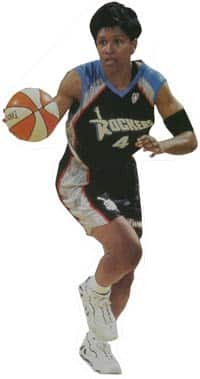
The growing popularity of the WNBA and other professional women’s athletics means that more attention is also being paid to young women athletes. Teenage basketball players flock to summer sports camps, where they play before visiting college coaches looking to recruit tomorrow’s players. Sports scholarships, once the domain of male jocks, are increasingly available for young women. But schools still tend to cut back on women’s sport facilities, equipment and staff when budgets have to be pared, claiming they don’t make money at the collegiate level – while the same is often true for male student sports as well. Beyond the number of T-shirts and tickets sold, the WNBA is having an impact on female lives that is less quantitative but perhaps more lasting. Such sports give women a common language and experience, which men have long possessed, helping them to cross age, ethnic, and class barriers. It also gives them a sense of community, says Mary Jo Kane, Ph.D., a sports physiologist and director of the Tucker Center for Research on Girls and Women in Sport at the University of Minnesota. And it improves women’s relationship with men, she believes. “Men have respect for sport; it provides commonality and respect between the sexes, gives them a common language and makes them less suspicious of each other.”
For females of all ages, it provides another dream for them to pursue, says Kane. “Athletic heroes who look like them, who have ponytails, who have babies. Sports teach women and girls confidence, self esteem, discipline, commitment, perseverance, reliability, how to bounce back from failure, set goals and achieve them, and teamwork.” All attributes that will serve women well in their professional lives, particularly if they want to rise to executive level. How all this will impact upon larger issues of women’s collective politics is yet to be determined. Professor Kane cites studies done with women’s intercollegiate basketball and hockey teams, which suggest that while young women see sports as an arena of empowerment where they are seeking a common goal with other women, they also tend not to associate what they are doing with any broader political implications. “They isolate their experience from a larger collective of women,” she says. This may be disconcerting news to women who are rushing out to start consciousness-raising Softball teams, but to Kane and her colleagues it just means that the effects of a sporting boom among women need to be traced through less direct routes. Media, as one of our culture’s most powerful avenues for the transmission of cultural values, has brought the stories and images of women in sports to many who have some level of feminist consciousness but little or nothing to do with athletics. The question of what women collectively do with this information is as yet unanswered. Sports psychologists and feminist scholars are hopeful that the experience of women winning, losing, and struggling together will have many positive lessons for the large women’s community.
“I think we can expect more open and direct communication between women because of their involvement in sports, as they get used to being in the trenches together,” says Kane. We may also see more concern and respect by women for women, she theorizes, that allows them to see each other as partners, and be less likely to want to hurt their friendships with women in competing for the attention of men. “Overall, women in sports tend to be leaders in other areas of life and in this way can set an example of women being confident, disciplined and focused.”
At a younger age, studies show that girls who participate in sports are less likely to become substance abusers, or get pregnant while still in school, and more likely to graduate. They are less likely, too, to become victims of abuse. As the number of eating disorders soars in teenage girls, who confuse body image with self image, its comforting to hear the Liberty’s Teresa Weatherspoon pronounce that, “It’s not what you look like, how fast, or how tall you are. It’s the size of your heart and about having confidence in yourself.”
Next basketball season, look (for two new teams to join the I WNBA, based in Washington D.C. 1 and Detroit. The latter will be the sister team to the NBA’s Detroit Pistons, “We watched closely as the WNBA grew from a dream to an exciting reality,” says Tom I Wilson, president of the Pistons. We’re delighted to be part of the most dynamic new league in sports.”
New Yorker Angell Delaney frequently writes about sports when she’s not participating in them. A former NCAA Division I discus thrower, she currently plays center on an Urban League basketball team, is a long distance runner and cyclist, and is working toward her black belt in Tae Kwon Do.
© 1998 – 2010 On The Issues.
